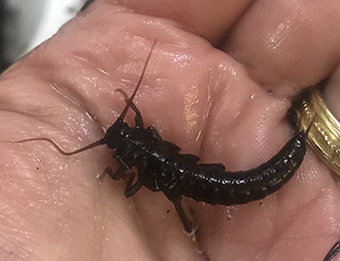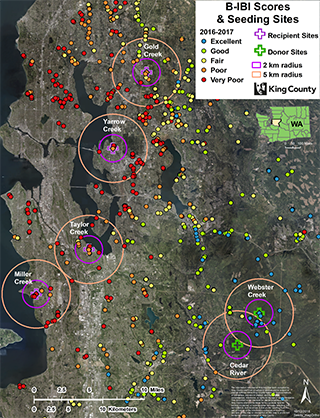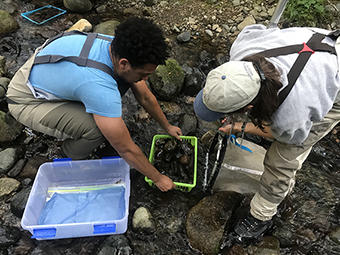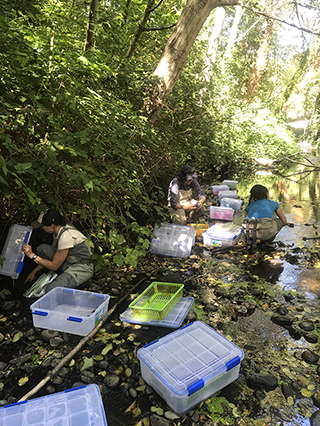Stream bug seeding project
A novel strategy to help stream communities recover
This project aimed to jump-start the recovery of several degraded King County streams. This project seeded these streams with macroinvertebrates (“stream bugs”) collected from healthy streams. Healthy streams support a diverse stream bug community. This includes many types of sensitive mayfly, stonefly, and caddisfly larvae. They also support a suite of other insect larvae, snails, worms, crayfish and clams. The Benthic Index of Biotic Integrity (B-IBI) is a way of measuring stream health using stream bugs. It relies on counts of the different types of sensitive taxa. When conditions degrade and sensitive taxa disappear, B-IBI scores decline.
How did we seed bugs?
In the summer of 2018, we collected stream bugs from healthy streams. We then transported (or "translocated") these bugs to four specific streams. We selected these streams because they had good habitat or were recently restored. But, these streams contained few sensitive bug species and had low B-IBI scores. We suspected one reason might have been that the streams had no nearby source of sensitive taxa. The urban basins surrounding these sites lack healthy macroinvertebrate communities. This may limit ecological recovery of these streams, even when conditions were suitable. Reintroducing these sensitive native species might speed up recovery of the stream community.
Thanks to our enthusiastic team, the translocation went as planned. We moved approximately 46,000 macroinvertebrates to each of the four “recipient” streams. The recipient streams include:
- Taylor Creek in Seattle;
- Gold Creek near Woodinville;
- Miller Creek in the City of Normandy Park;
- A tributary of Yarrow Creek in the City of Bellevue.
We collected samples in the recipient streams before seeding. These samples confirmed there were few sensitive species present before the experiment. Typical B-IBI scores in the recipient basins were poor or very poor. We also collected samples from the two "donor" healthy streams. We then compared species lists between donor and recipient streams. We found that on average, recipient streams received:
- 15 new mayfly taxa;
- 9 new stonefly taxa;
- and 13 new caddisfly taxa.
We did not expect all these new taxa to persist in the recipient streams. But the persistence of even a few new taxa would be important. It would suggest the streams could support a more diverse and sensitive suite of taxa.
Did it work?

Seeding the streams appears to have been partly successful. In all four recipient streams in 2019 (one year post-seeding), we found at least one new or possibly new taxon. In two of the four streams, B-IBI scores increased in part because of those new taxa. But, many of the translocated new taxa were not found in post-seeding samples. Also, for those new taxa that we did find, we do not yet know if they will thrive there for many generations. For those reasons, we conclude that the project was only partly successful.
Summary of results by stream, one year after seeding:

Click here for a larger view of the study map.
- Gold Creek: We found three new or possibly new taxa. These included a stonefly, caddisfly and a fly. Most surprising was the 37 point increase in B-IBI score a year after seeding.
- Taylor Creek: We found three possibly new taxa. These included a beetle, midge, and a caddisfly. The B-IBI score increased 16 points a year after seeding.
- Yarrow Creek tributary: We found one new stonefly a year after seeding. But, the B-IBI score did not improve.
- Miller Creek: We found four new or possibly new taxa. These include a mayfly, midge, crane fly and stonefly. But, the B-IBI score did not improve.
The results suggest bug seeding is a plausible action when done with care. In appropriate locations, bug seeding can help restore diverse macroinvertebrate communities.
Don’t do this on your own
Bug seeding may be appropriate in some cases. But do not transplant invertebrates on your own. Moving any organisms from one stream to another requires permits and careful planning. Otherwise, there is a risk of transporting pathogens or non-native species.
There are many things you can do to help restore water quality and improve stream habitats. Activities include installing rain gardens at your home. You can also encourage local planners to put in place effective stormwater controls. Helpful actions are those that:
- reduce delivery of contaminants and sediments;
- protect riparian areas;
- restore natural stream flows.
These are all key factors needed to protect and restore freshwater quality.
Project documents
- Final report – Bug Seeding: A Possible Jump-start to Stream Recovery, June 2020
- Quality Assurance Project Plan: Invertebrate Supplementation as Restoration Action in Select B-IBI Basins
- Poster presented at Symposium on Urbanization and Stream Ecology, in Austin, Texas, February 2020
Figures
- Figure 1: Map of donor and recipient sites and recent B-IBI scores from those and other sites in King County
- Figure 2: Colonization baskets, used to collect bugs in Webster
- Figure 3: Collecting colonization baskets on moving day
- Figure 4: Releasing bugs in Miller Creek in 2018
- Figure 5: A stonefly nymph that survived a year in Gold Creek

 Translate
Translate

